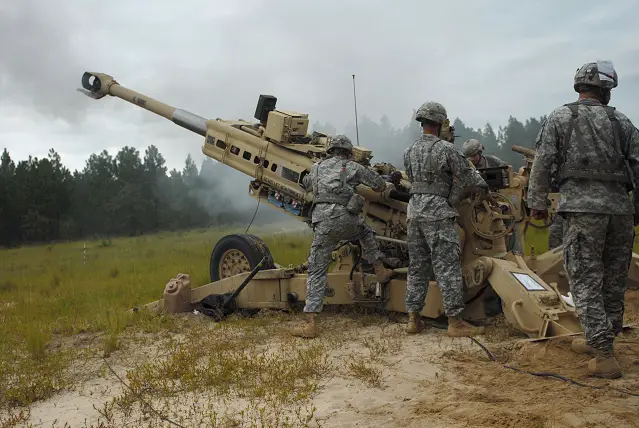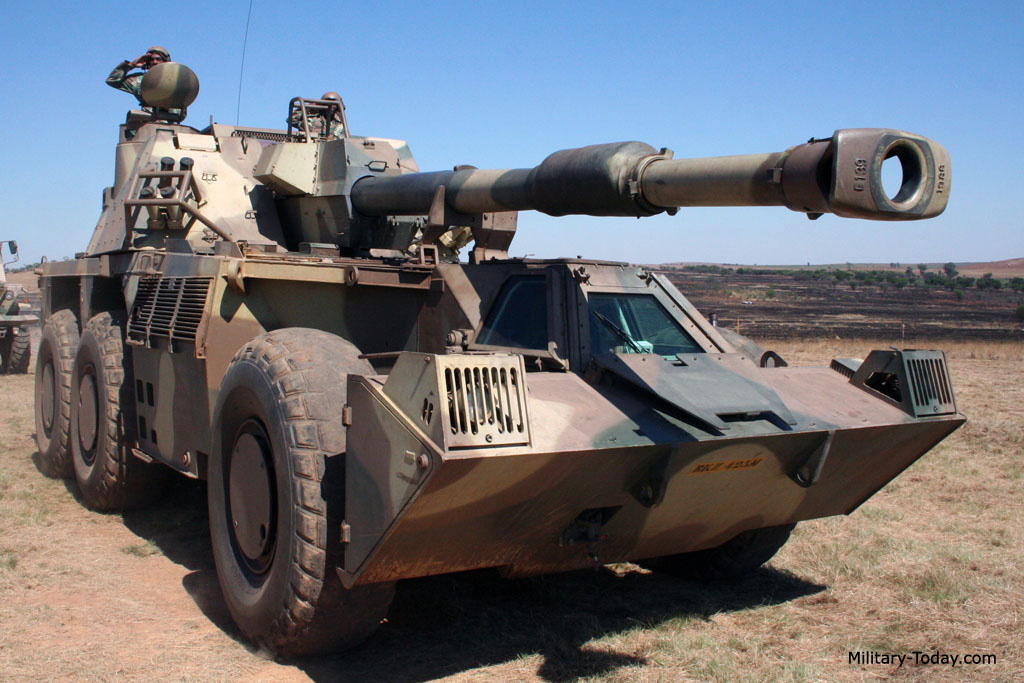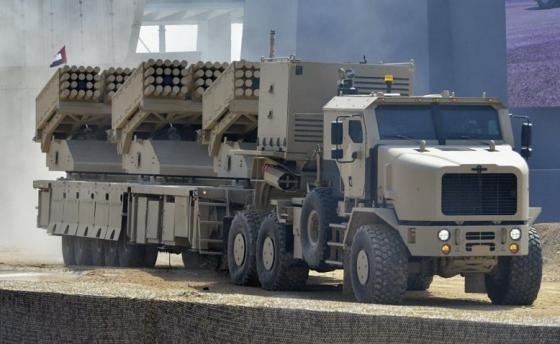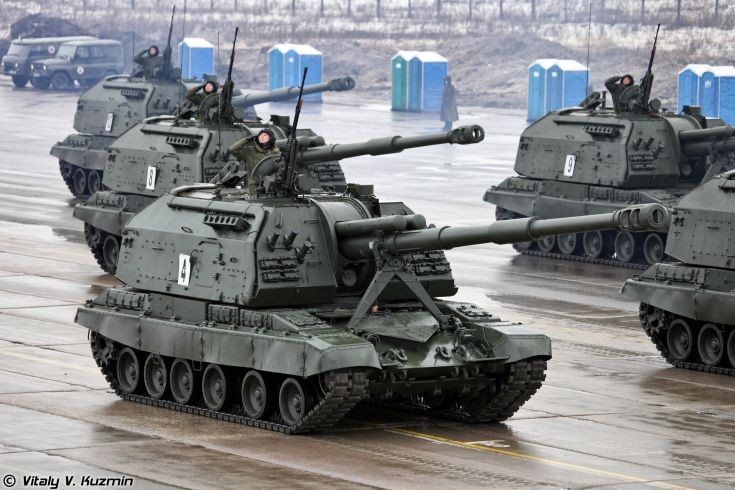Indus Falcon
SENIOR MEMBER

- Joined
- Mar 4, 2011
- Messages
- 6,910
- Reaction score
- 107
- Country
- Location
Artillery Experiment Shows Deepening UK-French Ties
Jun. 21, 2014 By ANDREW CHUTER and PIERRE TRAN

Eyes on CAESAR: Sources say the British hope to train on a French Army CAESAR howitzer vehicle. Here, a CAESAR parades before a rugby game outside Paris in May. (THOMAS SAMSON/AFP/Getty Images)
PARIS— London is in talks with Paris to allow British troops to train on a French system artillery system this year, according to sources, the first step in a sweeping review of all British artillery requirements, from mortars to guided rockets to 155mm artillery.
The move would also mark a deepening of ties between the two governments, which agreed four years ago to cooperate on defense matters.
Training with Nexter System’s truck-mounted CAESAR 155mm artillery system would be part of an experimentation phase being conducted by the UK’s Defence Science and Technology Laboratory and the Defence Equipment and Support organization to assess British artillery requirements, sources familiar with the program said.
A French Army officer confirmed talks with the British Army on showing the CAESAR are underway, but said “This has not been definitively fixed ... The discussions are going on.”
The talks are being held under the 2010 Lancaster House bilateral defense treaty, which among other things calls on the British and French armies to seek areas of cooperation on their equipment, the officer said.
The French Army already operates the truck-mounted CAESAR — short for Camion Equipé d’un Système d’Artillerie
—and the weapon has been successful in several export markets.
The British Army is already assessing the capabilities of another piece of Nexter equipment: the véhicule blindé de combat d’infanterie (VBCI) 8x8 infantry fighting vehicle.
The two governments are expected to outline a further round of cooperation efforts involving their respective armed forces around the end of this month, according to one source.
Philip Dunne, the British defense procurement minister, told reporters during a June 19 briefing at the Eurosatory defense exhibition in Paris that the two sides are having some success looking for new initiatives on which to cooperate.
“Following the summit in January we are looking to find other things over a period of time where our two equipment programs align,” Dunne said. “I’m pleased to say there are a number of opportunities emerging.”
BAE Systems’ Terrier combat engineering vehicle would be one of the British land equipment items evaluated by France, he said.
The arrangement to train and experiment on CAESAR is set to be another cooperation contender.
An industry executive said the plan is to send 15 to 20 British artillery personnel to a French Army base to train on the gun “towards the end of this year.”
Several years ago, the British evaluated CAESAR in competition with BAE Systems’ M777 towed lightweight 155mm howitzer, but the program came to nothing.
It’s possible the British will conduct a parallel 155mm experimentation phase with the towed M777 using weapons on loan from the US military, which is the howitzer’s biggest customer.
There is no new artillery program on the stocks in London, but that could come later in the decade when the Army decides what to do about replacing or updating its 40-year-old 105mm light gun, the self-propelled AS90 155mm howitzer and other artillery.
The British are in a preconceptual stage of work reviewing all areas of their artillery capability, the source said.
“They are using CAESAR as a representative 155mm platform and keeping options open at this stage. While training to use CAESAR, they have not ruled out the M777,” the source said.
It appears the experimentation work is not just focused on 155mm, but will review the 120mm mortar and guided multiple launch rocket system and other capabilities. The aim is to determine the characteristics for the next generation of artillery, the source said.
The move to examine CAESAR is the second time this year the British have begun an assessment of a major French land platform.
A VBCI 8x8 infantry fighting vehicle was delivered to the UK in the sidelines of an Anglo-French summit between Prime Minister David Cameron and French President François Hollande in January.
That evaluation is being taken a step further, with around 130 British troops being dispatched to the South of France this summer to train on the vehicle.
The French website FOB reported recently that, following conclusion of the training next March, the British will have up to 20 of the wheeled 8x8 vehicles put at their disposal for further evaluation.
The British are referring to this as “experimentation,” hoping to avoid the appearance that this is a trial or competition, the sources said.
As part of the growing cooperative tie between the two sides, French Army Chief of Staff Gen. Bertrand Ract-Madoux invited his British counterpart, Gen. Sir Peter Wall, to the French mission in Mali this year, and showed the VBCI to the British commander, the officer said.
The British had a shot at acquiring a new wheeled armored personnel carrier in 2008 as part of the FRES utility program, but the deal collapsed not long after the government selected General Dynamics Piranha 5 vehicle .
VBCI was one of the losing bidders in that competition.
Dunne said that since the original competition, the French have rectified what the British Army considered the vehicle’s shortcomings.
“We had a competition in which VBCI took part. Since then the vehicle has undergone quite a considerable upgrade in three particular areas where it fell short of our requirements,” Dunne said. “And in each of those areas, I am assured by the company that they can now meet the requirement so that is partly what we are looking to test.”
The procurement minister listed the power pack and the armored protection as two of the areas of previous concern. He said Britain is in the early stages of demonstrating vehicle capabilities.
“Right now, we don’t have a specific schedule for a program; it’s early days,” Dunne said. “The likelihood is we would need to compete. I can’t give you a categorical assurance that we will compete but it’s more likely [than not].”
The French Army is reckoned to have more VBCIs than it needs and Dunne didn’t rule out a temporary sharing arrangement when asked whether the two governments might consider such a move.
“Clearly it’s an option if there is a sufficient [VBCI] fleet that it makes sense for the French to consider. It’s unlikely that pooling and sharing will satisfy both armies’ requirements, but as a way of getting comfortable with the vehicle, I think it’s a very good idea, he said.
French industry hopes to win a British order for the VBCI has been tied to a reciprocal French purchase of the Watchkeeper UAV entering service with the British Army, French media have reported.
In the spirit of the cross-channel cooperation, French troops last year went to Britain to train on the tactical UAV, built by Thales UK in a joint venture with Elbit of Israel.
Watchkeeper was later evaluated by the French military at one of its training grounds.
The French officer said competition law required an open tender for the tactical UAV order. At one time London had hoped to strike a sole source deal with Paris on Watchkeeper procurement. That requirement for a UAV competition opens the door to rival bids from Airbus Defence & Security, Safran’s Sagem and others. ■
Artillery Experiment Shows Deepening UK-French Ties | Defense News | defensenews.com
Jun. 21, 2014 By ANDREW CHUTER and PIERRE TRAN
Eyes on CAESAR: Sources say the British hope to train on a French Army CAESAR howitzer vehicle. Here, a CAESAR parades before a rugby game outside Paris in May. (THOMAS SAMSON/AFP/Getty Images)
PARIS— London is in talks with Paris to allow British troops to train on a French system artillery system this year, according to sources, the first step in a sweeping review of all British artillery requirements, from mortars to guided rockets to 155mm artillery.
The move would also mark a deepening of ties between the two governments, which agreed four years ago to cooperate on defense matters.
Training with Nexter System’s truck-mounted CAESAR 155mm artillery system would be part of an experimentation phase being conducted by the UK’s Defence Science and Technology Laboratory and the Defence Equipment and Support organization to assess British artillery requirements, sources familiar with the program said.
A French Army officer confirmed talks with the British Army on showing the CAESAR are underway, but said “This has not been definitively fixed ... The discussions are going on.”
The talks are being held under the 2010 Lancaster House bilateral defense treaty, which among other things calls on the British and French armies to seek areas of cooperation on their equipment, the officer said.
The French Army already operates the truck-mounted CAESAR — short for Camion Equipé d’un Système d’Artillerie
—and the weapon has been successful in several export markets.
The British Army is already assessing the capabilities of another piece of Nexter equipment: the véhicule blindé de combat d’infanterie (VBCI) 8x8 infantry fighting vehicle.
The two governments are expected to outline a further round of cooperation efforts involving their respective armed forces around the end of this month, according to one source.
Philip Dunne, the British defense procurement minister, told reporters during a June 19 briefing at the Eurosatory defense exhibition in Paris that the two sides are having some success looking for new initiatives on which to cooperate.
“Following the summit in January we are looking to find other things over a period of time where our two equipment programs align,” Dunne said. “I’m pleased to say there are a number of opportunities emerging.”
BAE Systems’ Terrier combat engineering vehicle would be one of the British land equipment items evaluated by France, he said.
The arrangement to train and experiment on CAESAR is set to be another cooperation contender.
An industry executive said the plan is to send 15 to 20 British artillery personnel to a French Army base to train on the gun “towards the end of this year.”
Several years ago, the British evaluated CAESAR in competition with BAE Systems’ M777 towed lightweight 155mm howitzer, but the program came to nothing.
It’s possible the British will conduct a parallel 155mm experimentation phase with the towed M777 using weapons on loan from the US military, which is the howitzer’s biggest customer.
There is no new artillery program on the stocks in London, but that could come later in the decade when the Army decides what to do about replacing or updating its 40-year-old 105mm light gun, the self-propelled AS90 155mm howitzer and other artillery.
The British are in a preconceptual stage of work reviewing all areas of their artillery capability, the source said.
“They are using CAESAR as a representative 155mm platform and keeping options open at this stage. While training to use CAESAR, they have not ruled out the M777,” the source said.
It appears the experimentation work is not just focused on 155mm, but will review the 120mm mortar and guided multiple launch rocket system and other capabilities. The aim is to determine the characteristics for the next generation of artillery, the source said.
The move to examine CAESAR is the second time this year the British have begun an assessment of a major French land platform.
A VBCI 8x8 infantry fighting vehicle was delivered to the UK in the sidelines of an Anglo-French summit between Prime Minister David Cameron and French President François Hollande in January.
That evaluation is being taken a step further, with around 130 British troops being dispatched to the South of France this summer to train on the vehicle.
The French website FOB reported recently that, following conclusion of the training next March, the British will have up to 20 of the wheeled 8x8 vehicles put at their disposal for further evaluation.
The British are referring to this as “experimentation,” hoping to avoid the appearance that this is a trial or competition, the sources said.
As part of the growing cooperative tie between the two sides, French Army Chief of Staff Gen. Bertrand Ract-Madoux invited his British counterpart, Gen. Sir Peter Wall, to the French mission in Mali this year, and showed the VBCI to the British commander, the officer said.
The British had a shot at acquiring a new wheeled armored personnel carrier in 2008 as part of the FRES utility program, but the deal collapsed not long after the government selected General Dynamics Piranha 5 vehicle .
VBCI was one of the losing bidders in that competition.
Dunne said that since the original competition, the French have rectified what the British Army considered the vehicle’s shortcomings.
“We had a competition in which VBCI took part. Since then the vehicle has undergone quite a considerable upgrade in three particular areas where it fell short of our requirements,” Dunne said. “And in each of those areas, I am assured by the company that they can now meet the requirement so that is partly what we are looking to test.”
The procurement minister listed the power pack and the armored protection as two of the areas of previous concern. He said Britain is in the early stages of demonstrating vehicle capabilities.
“Right now, we don’t have a specific schedule for a program; it’s early days,” Dunne said. “The likelihood is we would need to compete. I can’t give you a categorical assurance that we will compete but it’s more likely [than not].”
The French Army is reckoned to have more VBCIs than it needs and Dunne didn’t rule out a temporary sharing arrangement when asked whether the two governments might consider such a move.
“Clearly it’s an option if there is a sufficient [VBCI] fleet that it makes sense for the French to consider. It’s unlikely that pooling and sharing will satisfy both armies’ requirements, but as a way of getting comfortable with the vehicle, I think it’s a very good idea, he said.
French industry hopes to win a British order for the VBCI has been tied to a reciprocal French purchase of the Watchkeeper UAV entering service with the British Army, French media have reported.
In the spirit of the cross-channel cooperation, French troops last year went to Britain to train on the tactical UAV, built by Thales UK in a joint venture with Elbit of Israel.
Watchkeeper was later evaluated by the French military at one of its training grounds.
The French officer said competition law required an open tender for the tactical UAV order. At one time London had hoped to strike a sole source deal with Paris on Watchkeeper procurement. That requirement for a UAV competition opens the door to rival bids from Airbus Defence & Security, Safran’s Sagem and others. ■
Artillery Experiment Shows Deepening UK-French Ties | Defense News | defensenews.com



























